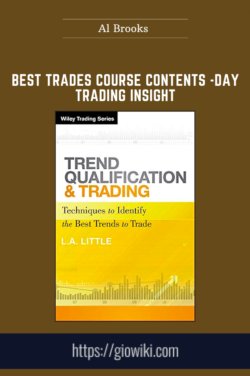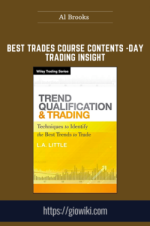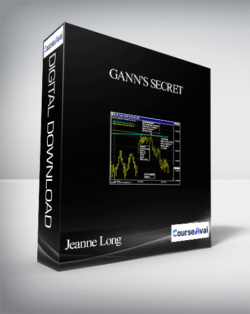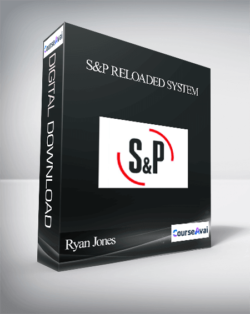Salepage link: At HERE. Archive: https://archive.is/wip/6r3hJBuy now $19 $69, Best Trades course contents – Day Trading Insight – Al Brooks Course.Best Trades course contentsTable of ContentsBest Trades course contentsCourse overviewModule 1: IntroductionUnit 1: Welcome and Course OverviewUnit 2: What is Price Action? (Q1-Q3)Unit 3: What is Price Action? (Q4-Q6)Unit 4: What is Price Action? (Q7-Q9)Unit 5: What is Price Action? (Q10-Q13)Module 2: Major Trend ReversalsUnit 6: Look for Swing TradesUnit 7: Major Trend ReversalsUnit 8: Why Is an MTR the Best Setup?Unit 9: Minor Trend ReversalsUnit 10: Major Trend Reversal ExamplesModule 3: PullbacksUnit 11: PullbacksUnit 12: Bar CountingUnit 13: Bull Channel PullbacksUnit 14: Bear Channel PullbacksModule 4: Trading Range ReversalsUnit 15: Trading RangesUnit 16: Trading Range ReversalsUnit 17: Trading Range Price ActionUnit 18: Wedge and Final Flag ReversalsUnit 19: Beginners Trapped, Experts FadeModule 5: BreakoutsUnit 20: What Is a Breakout?Unit 21: If Strong Breakout, Must EnterUnit 22: Weak Setup and Failed BreakoutUnit 23: Every Breakout Is a ClimaxUnit 24: 2nd Legs and 2nd Leg TrapsUnit 25: Strong Bulls and BearsModule 6: Concluding CommentsUnit 26: Concluding CommentsUnit 27: Best Trades ResourcesModule 7: Bonus VideosUnit 28: Order Flow Support for Price Action TradingCourse overviewThe Brooks Price Action Best Trades course empowers you with four trade entry setups you can use to make consistent money in any market. Whether you are a beginner or more experienced trader, the Best Trades course provides all you need to prove price action trading can work for you. And the only such proof is in making money.Module 1: IntroductionUnit 1: Welcome and Course OverviewVideo duration 03:47 minutesA warm welcome to the course and an overview of the four Best Trade setups you will be encouraged to focus on to simplify your trading, and achieve successful, consistent trading results.Unit 2: What is Price Action? (Q1-Q3)Video duration 11:21 minutesThe first of 4 units mining Al Brooks’ invaluable knowledge on a range of important questions. The first 3 questions you will hear on ‘What is price action?’ answered here are:Q1. What exactly is price action? Can you explain what price action is to someone who is just starting out as a trader? And why should a wannabe trader be interested in price action at all?Q2. Can a trader make a living trading off only the four best trade setups we have here? If yes, how should they go about learning and applying these setups?Q3. If context is all the bars to the left, just how far back to the left are we talking about? How does a trader know when, or where to stop looking to the left? And does whatever you say on this apply equally to all markets, including the ES Emini and Forex markets? And all timeframes?Unit 3: What is Price Action? (Q4-Q6)Video duration 13:46 minutesThe second of 4 units on What is price action? Here you will hear another three important questions answered, which are:Q4: Many traders find learning price action hard work. Learning to trade candlestick patterns is often promoted as an easy way to trade. How does trading price action differ from candlestick trading?Q5: Your popular ‘Trading price action’ books refer to technical analysis for the serious trader. How do you define a serious trader? Are you implying that less-than-serious traders should not attempt to learn price action?Q6: Can anybody learn to trade price action for a living? If so, what personal attributes are needed?Unit 4: What is Price Action? (Q7-Q9)Video duration 09:29 minutesThe third of 4 units on What is price action? Three more important questions answered:Q7: Some wannabe traders struggle finding time to learn how to trade. Maybe the day job requires too much time or energy. If beginning traders only have a couple of hours each day to devote to their trading, what advice would you give?Q8: Beginning traders often are advised by experts that they need to blow their accounts, some will say several times before they can really learn to trade. Do you agree with this?Q9: On your personal development path as a trader, can you recall your first significant insight into dropping what you were doing and using price action alone for trading?Unit 5: What is Price Action? (Q10-Q13)Video duration 08:26 minutesThe last of 4 units on What is price action? A final 4 important questions answered for your serious review:Q10: Can you imagine yourself starting out today as a 30-year-old trader? With all the diverse trading products available, how would you go about learning to trade? And how long should it take to become consistently profitable?Q11: If you could only give one piece of trading advice to a beginner, what would it be?Q12: With all the podcasts and interviews you have done, is there an important trading question you have expected but been surprised to have never been asked?Q13: Is there anything else that you would like to say to traders listening to this podcast?Module 2: Major Trend ReversalsUnit 6: Look for Swing TradesVideo duration 01:24 minutesLearn why swing trades should be the foundation of your trading business, whether a beginner or experienced trader. Patiently wait if needed for swing trades if you are looking to succeed in trading.Unit 7: Major Trend ReversalsVideo duration 14:03 minutesLearn what to look for when trading the Major Trend Reversal (MTR). Learn to be patient and allow the setup to evolve. There is no hurry, and no need to be impatient. Learning to take action on this MTR setup is important. The MTR could be the only setup you need to wait on, and trade to be successful.Unit 8: Why Is an MTR the Best Setup?Video duration 07:06 minutesLearn why the MTR is the best setup, not only for beginners but for experts too! The prime reason is time. Time is on your side as the setup develops. You will also learn that MTRs are easier to manage, and more.Unit 9: Minor Trend ReversalsVideo duration 03:49 minutesHere you will learn how to differentiate between a valid Major Trend Reversal, where a trend reversal results, and what may be a Minor Trend Reversal. Learn how Minor reversals lead to either continuation of the trend, or transition into a Trading Range.Unit 10: Major Trend Reversal ExamplesVideo duration 17:00 minutesSeveral Major Trend Reversal (MTR) examples for you to learn how to recognize them in real time. You get to study both bull and bear trend examples.Module 3: PullbacksUnit 11: PullbacksVideo duration 09:37 minutesLearn how to differentiate between pullbacks in a trend and a trading range. We are looking for swing trades in a strong trend, or scalps when trends are weak or market is in a Trading Range. You will also learn about implied, and most important, the 50% pullback.Unit 12: Bar CountingVideo duration 16:04 minutesBar counting is an effective way of finding pullback entries. Learn how to make good use of this technique to improve your trading. Bar counting will help you find and measure market moves in legs, identified by the bullish or bearish bar patterns you are counting.Unit 13: Bull Channel PullbacksVideo duration 22:37 minutesSome bar counting examples in both Tight and Broad Bull Channels to help you learn how to recognize pullbacks in real time.Unit 14: Bear Channel PullbacksVideo duration 12:39 minutesSome bar counting examples in both Tight and Broad Bear Channels to help you learn how to recognize pullbacks in real time.Module 4: Trading Range ReversalsUnit 15: Trading RangesVideo duration 13:43 minutesMarkets go up, markets go down. Markets also spend a lot of time going sideways in a two-sided pattern we call a Trading Range. Learn what identifies a Trading Range, a Tight Trading Range, and the success principles for trading with them. Learn also when NOT to trade!Unit 16: Trading Range ReversalsVideo duration 12:40 minutesLearn the crucial skills to Buy Low, Sell High, and Scalp when confronted with a Trading Range, especially when a Tight Trading Range. See how to be sure you are in a Trading Range and not a trend – as Trading Ranges do not last forever! Then you will learn how to trade in a Broad Trading Range.Unit 17: Trading Range Price ActionVideo duration 09:33 minutesHere you will learn more on validating whether you are in a Trading Range or not. Examples of Trading Range price action to watch for will give you the knowledge, skills, and confidence to trade. A discussion of probability in Trading Ranges is also included to help you assess and confirm Trading Range Reversal setups.Unit 18: Wedge and Final Flag ReversalsVideo duration 06:15 minutesWedges are common in Trading Ranges. This unit will help you to see these patterns and take appropriate trades. Final Flag reversals price action is also covered, giving you a well-rounded appreciation of trading Trading Range Reversals.Unit 19: Beginners Trapped, Experts FadeVideo duration 21:14 minutesSecond leg traps are common in Trading Ranges. Learn how recognize potential traps to trade like an expert. Learn when to fade the move (ie trading in opposite direction) rather than falling into the beginners trap! Learn more on the importance of limit order trading versus stop trading.Module 5: BreakoutsUnit 20: What Is a Breakout?Video duration 10:00 minutesYou start with leaning the important definition of a breakout. It can be a breakout of anything, but only as long as the breakout is strong, with adequate follow-through. When you see a strong breakout, because of the momentum, you need to get into the trade quickly! Successful breakout trading is difficult emotionally, so included is an important discussion on emotions.Unit 21: If Strong Breakout, Must EnterVideo duration 09:52 minutesWhen a breakout is strong, you must train yourself to enter! This unit deals with implications of taking the trade. It will help you overcome the natural resistance to taking action. Learn price action principles to identify and help you take strong breakout trades. Appropriate trade management skills once in the market will give you the confidence needed.Unit 22: Weak Setup and Failed BreakoutVideo duration 12:15 minutesMost breakouts fail! So here you learn more about failed breakouts to improve your performance. If a trade is too weak, you do not take it and hope for the best. But, the introduction of small pullback trends will help you stay in breakout trades when the market conditions are right.Unit 23: Every Breakout Is a ClimaxVideo duration 14:28 minutesA detailed discussion on climatic reversals (failed breakouts) and Exhaustion and Measurement Gaps. You will also learn about exhaustive Buy and Sell Climaxes. You will gain more perspective on breakouts to help you succeed with these potentially lucrative swing trades.Unit 24: 2nd Legs and 2nd Leg TrapsVideo duration 12:58 minutesMore detailed discussion on the importance of 2nd Legs and 2nd Leg Traps. Learn why the 2nd Leg after a strong breakout should be your minimum goal for taking profits. Traps often form before a breakout, so learn more about what to be looking for.Unit 25: Strong Bulls and BearsVideo duration 12:30 minutesLearn about the importance of identifying strong bulls and bears in the market. You learn trade management skills for taking profits, as well as getting out to prevent or reduce losses. This unit will also help you bring together many parts of the course to fine tune your trading skill set.Module 6: Concluding CommentsUnit 26: Concluding CommentsVideo duration 04:21 minutesWrapping up the course encouraging you to study all 4 Best Trades setups well, putting in the study time if not done already.To further help your trading, an introduction to trading psychology may just open your mind to possible mental barriers affecting your performance. Follow up the topics to learn more, as our human brains are not actually wired well for trading. Just the opposite!And some invaluable trade management tips for ‘breaking your state’. Just try and see what effect it has for you. All designed to help you ‘Focus’, take ‘Action’ when you see a setup, and the ‘Results’ will follow. Good luck.Unit 27: Best Trades ResourcesVideo duration 10:11 minutesAn introduction to Best Trades resources to help you further in your trading. This unit gives brief reviews of the Brooks Trading Course and Jigsaw Trading websites. Then some book recommendations, including a valuable book on Mindfulness. And an effective biofeedback tool for building your trading mindset and self awareness.Module 7: Bonus VideosUnit 28: Order Flow Support for Price Action TradingVideo duration 63:20 minutesThis unit introduces the Jigsaw order flow trading tool that was shown in the Bonus Resources lecture. You will learn how the market operates, something that most traders actually do not know! In addition, you will learn from market replay recordings showing how the Best Trades setups appear, and how order flow can support price action trading.Video Outline00:00 – Introduction preamble01:00 – Agenda review01:48 – Order flow trading background, Depth of Market05:55 – Market auction process12:15 – Trading with the DOM, prop shops, order flow tools, us vs them15:25 – How to use order flow22:00 – Market replay examples intro24:50 – 21 October, 201653:30 – 27 October, 201659:00 – Learning order flow trading60:25 – Unfiltered data need61:03 – Review and close62:10 – End
 Master Indicator – Lance Ippolito
₹20,418.00
Master Indicator – Lance Ippolito
₹20,418.00
 Course 2: Professional Trading Masterclass (PTM – Video Series 2.0) [2021] – Anton Kreil
₹64,408.00
Course 2: Professional Trading Masterclass (PTM – Video Series 2.0) [2021] – Anton Kreil
₹64,408.00
Best Trades course contents – Day Trading Insight – Al Brooks
₹3,154.00






